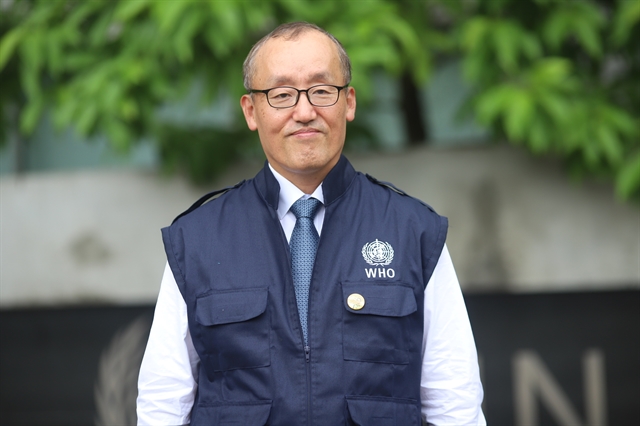 Society
Society

On World Drowning Prevention Day July 25, Dr Kidong Park, WHO Representative in Việt Nam, speaks about the importance of drowning prevention and the measures necessary to protect children from drowning in Việt Nam.

|
| Dr Kidong Park, WHO Representative in Việt Nam |
Drowning has been the cause of over 2.5 million deaths globally in the last decade. The World Health Organisation (WHO) estimates that about 235,600 people lost their lives due to drowning in 2019. On World Drowning Prevention Day July 25, WHO Representative in Việt Nam, Dr Kidong Park, tells Việt Nam News about the importance of drowning prevention and measures necessary to protect children from drowning in Việt Nam.
Could you please tell us about the current global drowning situation and the meaning of the recent United Nations Resolution on drowning prevention?
Drowning has been the cause of over 2.5 million deaths globally in the last decade. WHO estimates that about 235,600 people lost their lives due to drowning in 2019. This figure excludes drownings attributable to flood-related disasters and water transport incidents.
Drowning is among the ten leading causes of death for children aged 5-14 years. Nine of every 10 deaths from drowning happen in rivers, lakes, wells, domestic water storage vessels, and swimming pools in low- and middle-income countries. Every single death of a child from drowning has a tragic and profound impact on families and communities.
We all know that drowning is preventable, yet this issue has not received enough attention.
Thus, it was a historic moment when the United Nations General Assembly adopted a resolution on drowning prevention by consensus among all 193 Member States of the UN. This resolution draws clear connections between drowning and its negative impacts on Member States’ sustainable development goals. It also shows the relevance of drowning and its prevention to various initiatives and agreements for addressing climate change and reducing disaster risk.
The resolution proclaims July 25 every year as World Drowning Prevention Day. It will provide a good opportunity to raise awareness of the importance of drowning prevention and the need for urgent, coordinated and multisectoral action on life-saving solutions.
Could you please tell us the recommendations of the United Nations to its member states to prevent drowning? In the context of Việt Nam, what are your recommendations for effective measures to be implemented?
The United Nations resolution encourages all Member States to develop a national drowning prevention program in line with WHO recommended interventions. These include:
Improving flood risk management;
Installing barriers controlling access to water;
Providing safe places away from water such as crèches for pre-school children with capable childcare;
Teaching swimming, water safety and safe rescue skills;
Training bystanders in safe rescue and resuscitation;
Setting and enforcing safe boating and ferry regulation; and
Improving flood risk management.
The United Nations resolution also recommends the following policy actions to Member States:
Ensure enactment and effective enforcement of water safety laws, across all relevant sectors, in particular areas of health, education, transportation and disaster reduction.
Introduce water safety skills, swimming skills and first aid lessons as part of school curricula.
Encourage integration of drowning prevention within existing disaster risk reduction programmes.
Strengthen civil registration and vital statistics data, which include drowning deaths.
Promote drowning research, capacity building and international cooperation.
In the context of Việt Nam, the WHO estimates that the drowning mortality rate among children aged 0 – 14 years in 2019 was 5.70 per 100,000 population. This is higher than the global average of 4.20.
Việt Nam should consider the recommendations of the UN Resolution and adopt policies and programmes appropriately and effectively accordingly. It is important to ensure that our children are protected from drowning. That starts with teaching them swimming and water safety skills.
What do you think about the results of drowning prevention activities for children in Việt Nam in recent years?
Let me start with good news. In the last two decades, Việt Nam was able to reduce child deaths from drowning – from 19 children per 100,000 in 2000 to about 6 children per 100,000 in 2019.
To support the Government, WHO and partners have implemented intensified programmes on drowning prevention in selected provinces with the highest rates of drowning. Some results are encouraging. More than 30,200 children received water safety lessons. In addition, we have developed guidelines on safe swimming and water safety skills for children and this will be deployed nationwide.
To make a lasting difference in the lives of children, Việt Nam needs to sustain the drowning prevention interventions that have been successfully implemented in recent years and scale up these interventions in the whole country.
In the context of complicated developments of COVID, what advice do you have for families and children to ensure safety and prevent drowning?
During the COVID-19 outbreaks, there are fewer opportunities for children to swim in pools where parents can monitor them. Children may be tempted to play in open bodies of water with higher risk.
Thus, parents and guardians should take the following actions:
Talk to your children about the risk of drowning and supervise them closely to prevent drowning
Install barriers to control children’s access to open water
Make swimming safe for your kids
Teach your children water safety skills
Create a safe environment for children to prevent drowning
Besides that, we must also continue to take a series of public health measures to reduce the risk of COVID-19 transmission, as the 5K measures: wear facemask, disinfect frequently, keep safe distance, avoid crowds and public gathering, and fill out health declaration.— VNS